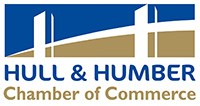Chamber business leaders hear about huge climate change risk to Humber towns and city

The Environment Agency’s Philip Winn and Lucy Marshall with Chamber President Kathy Fillingham (centre).
AFTER what felt like endless weeks of torrential rain which led to serious flooding in Lincolnshire and Yorkshire, a timely presentation by the Environment Agency brought the flood risk in the Humber region into sharp focus.
The Hull & Humber Chamber’s highest policy-making body, Chamber Council, was left in no doubt of the threat rising sea levels pose to large areas of the Humber, including Hull, Grimsby, Cleethorpes, Goole, Gainsborough, Doncaster and Selby.
The Environment Agency’s Philip Winn and Lucy Marshall told the Chamber that in 2013 when the Humber was last hit by major flooding which affected large parts of Immingham docks, South Ferriby and parts of Hull, the region was only centimetres away from the most catastrophic flooding around the Humber since 1953.
Philip told Chamber leaders that ultimately, if sea levels continue to rise as predicted, a tidal barrier similar to that in the River Thames, but four times as big may be required to protect low lying areas bordering the river, but that could be decades away and would cost billions of pounds.
He highlighted that the Environment Agency and all 12 local authorities around the Humber Estuary were presently trying to find an approach towards an agreed 25-year plan.
The Environment Agency’s current budget is circa £150-million for each six-year (2015-21) planning period for the Humber, and much work has been done since the 2013 floods to protect the most “at risk” areas of Lincolnshire and East Yorkshire. The plans are now focused on allowing farmland to flood when water levels are high in order to protect built-up urban areas.
In 2013, 40km of river bank around the Humber and its tributaries were breached and 1,100 properties damaged. The Agency director noted that the Humber region had now declared its intention to be net carbon neutral by 2040, but said this would be a “tough challenge” to achieve, noting the various heavy polluting companies in the area.
With the River Humber draining one-fifth of England with its tributary rivers including the Hull, Ouse, Trent and Derwent all feeding into it, atmospheric pressure and tidal changes together can mean the water level rises by up to two metres at peak times of the year.
Lucy Marshall added that the Environment Agency was also looking at how we can best “Live with Water” and was engaging with key stakeholders, landowners and the NFU, as farmers increasingly need to be compensated if their land is deliberately flooded as part of wider flood prevention schemes.
Chamber Chief Executive, Dr Ian Kelly, welcomed the update from the team at the Environment Agency for the Humber and commented: “The scale of the flooding challenge facing the Humber was the biggest in the UK outside London. Innovative ideas and proposals are now coming forward to defend our area in the face of high tides and flash flooding, but we suspect much more than £150-million for each six year planning period will be needed in the future. That is aside from the costs associated with decarbonising the Humber economy itself.
“We are doing great work in offshore wind development thanks to Ørsted, Siemens and ABP, but much more urgency will be required by the next Government to tackle the wider climate change crisis we now face.”
Anyone who would like to follow the Environment Agency on social media can find it at @Humber_Strategy on Twitter and @HumberStrategy on Facebook.






















